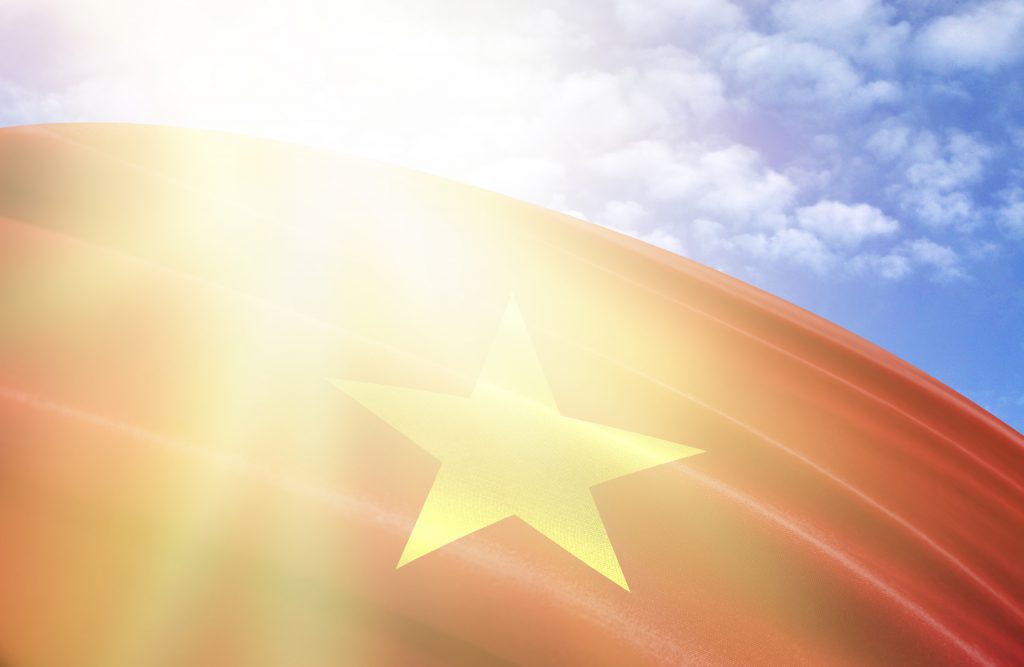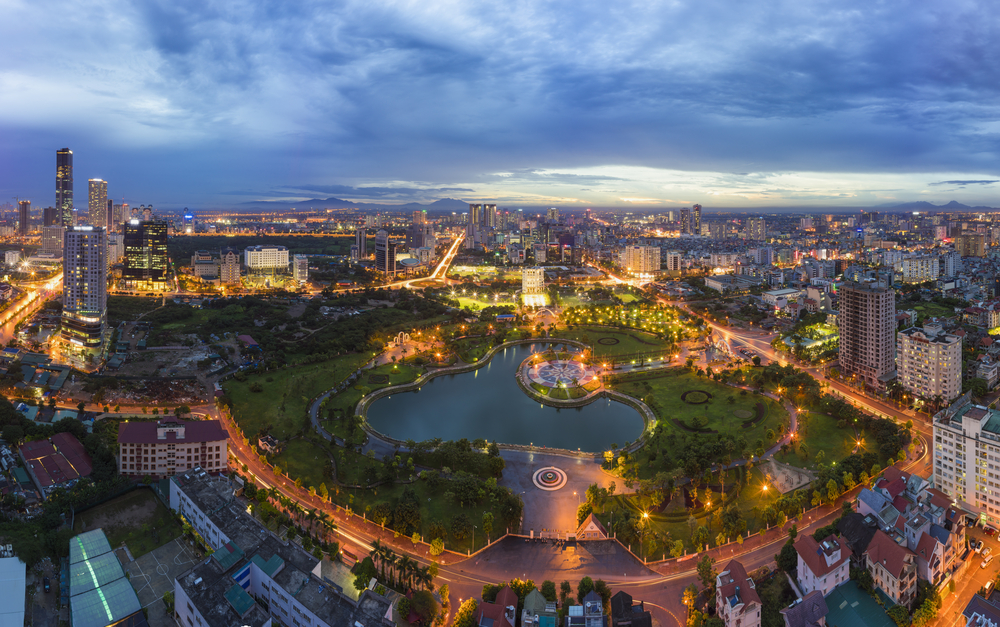Vietnam is among the ”brightest” spots in Asia despite the challenge containing the coronavirus pandemic, and its economy is poised to rebound, says CNBC quoted a UBS economist saying in early July.
“Vietnam is suffering some pain from the impact of COVID-19, but the outlook is looking one of the brightest in the region”, said Edward Teather, ASEAN economist at UBS Research.
The International Monetary Fund forecasts Vietnam’s economic growth will be 2.7% in 2020 and at the end of July, the World Bank had forecast Vietnam’s GDP to grow by 2.8%, the fifth-fastest rate in the world. However, Vietnam’s government is making every effort to keep growth above 5%. In order to gain this goal, the government seeks to increase public and private investment since January to help the economy emerge from the coronavirus pandemic.

Huge Investments
In June, Vietnam approved its biggest commercial project this year, a $9.3 billion tourist resort led by Vingroup, Vietnam’s largest private conglomerate. Foreign investors will also participate in the project, regarded as the largest investment in the country in recent years.
Besides Vingroup’s project, the Vietnamese Authorities have also given green light to more than a dozen major investments in the first half of this year. Other major projects include a $208 million highway in the Mekong Delta, a $52 million industrial park in Binh Phuoc Province, and three golf courses in northern provinces worth a total of $130 million. Eight component projects of the North-South Expressway, worth about $4.47 billion, were shifted from public-private partnerships to fully public investments in April, according to the Financial Times.
Vietnam set the target of attracting $35-36 billion in foreign direct investment (FDI) this year. By the end of July, there were 32,391 valid FDI projects in Vietnam with the total registered capital of $380.6 billion, $221.8 billion was disbursed.
In the first seven months of 2020, Vietnam attracted a total sum of $18.82 billion, equivalent to 93.1% attracted in the same period last year. A sum of $10.12 billion was disbursed in the seven-month period, equivalent to 95.9% of last year’s mount. Just in July, Vietnam attracted $3.15 billion in FDI and capital for share purchases, representing a rise of 79.8% against the same period last year and 76.2% against June.
According to Japan External Trade Organization (JETRO), 15 out of 30 Japanese firms chose Vietnam as the destination for production expansion within the Japanese government’s program to support Japanese firms to diversify their value chains in foreign countries. In the survey in December 2019, conducted online by NNA Japan Co., a Kyodo News group, Vietnam received 42.1% of the 820 valid responses, based on factors such as potential as a growing market and large supply of skilled, low-cost labor, according to the Kyodo news.
Apple looked for managers and engineers in Hanoi and Ho Chi Minh City. It is said that the company produces 3-4 million wireless earphones (AirPods) in the country in this year
There have been many reports that a large number of major foreign companies would choose Vietnam as theirs next manufacturing hub. Apple looked for managers and engineers in Hanoi and Ho Chi Minh City. It is said that the company produces 3-4 million wireless earphones (AirPods) in the country in this year. In addition, Google also begins production of its low-cost smartphone with Vietnamese partners this year, while Microsoft was scheduled to produce notebooks and desktop computers in the northern region in the second quarter.
EVFTA comes into effect
The European Union-Vietnam Free Trade Agreement (EVFTA) took effect on August 1st, 2020, paving the way for increased trade between the EU and Vietnam. The EVFTA was signed in June 2019, together with the EU-Vietnam Investment Protection Agreement (EVIPA). The EU has been one of Vietnam’s leading trading partners for many years, with two-way trade revenue of $56.4 billion in 2019, including revenue of $41.5 billion from Vietnam’s exports to the EU and $14.9 billion from Vietnam’s imports from the EU.
According to the agreement, when the EVFTA takes effect, the EU immediately eliminate import duties on some 85.6% of tariff lines, accounting for 70.3% of Vietnam’s exports to the bloc. The EU will gradually eliminate 99.2% of tariff lines, accounting for 99.7% of Vietnam’s exports, over seven years. As for the remaining 0.3%, it will give Vietnam tariff quotas with import duties of zero percent.
The EVFTA is the EU’s second deal with an ASEAN country, after Singapore, and one of few with a developing country. The EU Commission estimates that the agreements would help exports to Vietnam increase by 29% in 2035 and increase its GDP to $29.5 billion.

In May, the World Bank said that the EVFTA could boost Vietnam’s GDP and exports by 2.4% and 12% respectively by 2030. EU investors are active in 18 economic sectors and in 52 out of 63 provinces in Vietnam. Investment has been the most prominent in manufacturing, electricity, and real estate. The EVFTA reflects the EU’s wish to expand cooperation with ASEAN and participate more actively in ASEAN-led mechanisms. Accordingly, the EU supports Vietnam’s role as ASEAN Chair 2020 in promoting cooperation between Vietnam and the EU, as well as between ASEAN and the EU.
The EVFTA will also create new milestones for Vietnam’s international economic integration process. It will elevate and deepen the comprehensive cooperative partnership, while also contributing to strengthening cohesion between the two regions.
U.S. official positions on the South China Sea
Chinese aggression in the South China Sea is on the rise. Ever since the outbreak of the coronavirus disease (Covid-19) in Wuhan, China in late 2019 and early 2020, researchers have warned that Beijing authorities would increase their belligerent activities in the South China Sea for the post-COVID-19 period. Such warning has come true, as Beijing has repeatedly committed aggressive actions in the South China Sea in the last months, while the pandemic rages all over the world.
The World Bank said that the EVFTA could boost Vietnam’s GDP and exports by 2.4% and 12% respectively by 2030. EU investors are active in 18 economic sectors and in 52 out of 63 provinces in Vietnam
Beginning a series of recent activities, Chinese maritime vessels had sunken Vietnamese fishing boats in the Paracel Islands, causing a public outcry. In spite of the focus on combatting the COVID-19 epidemic, the US State Department, the Department of Defense, and Senators have strongly protested against Chinese maritime vessels’ aggressive actions against Vietnamese fishing boats.
The Philippines also strongly condemns such inhumane actions by Chinese maritime vessels, despite the need to enlist China’s support.
Following the sinking of Vietnamese fishing vessels, China sent the Liaoning carrier strike group into the South China Sea to conduct military exercises and to scare off neighboring countries. Afterward, China brought in the Haiyang Dizhi 08 geological survey ship as well as other maritime and militia vessels (which have invaded Vietnam’s exclusive economic zone and continental shelf in 2019) so as to operate within the waters of countries along the South China Sea. The Haiyang Dizhi 08 geological survey ship group conducted surveys in the exclusive economic zone and continental shelf of Malaysia.
On April 18, 2020, the U.S. State Department had condemned China’s bullying; expressing concern over China’s repeated provocative actions aimed at offshore oil development by other countries in the South China Sea; demanding that China stop these acts of bullying and avoid further provocative and destabilizing activities.
On July 13, 2020, the U.S. State Department officially rejected China’s “nine-dashed-line” maritime claims in the South China Sea, affirming a 2016 ruling under the U.N Convention on the Law of the Sea. In an official statement of the U.S State Department, U.S. Secretary of State Mike Pompeo said China’s claims to offshore resources across most of the South China Sea are “completely unlawful”, as is Beijing’s campaign of bullying to control them. China has offered no coherent legal basis for its ambitions in the South China Sea and for years has been using intimidation against other South Asian coastal states, U.S. Secretary of State Mike Pompeo said in the statement. The U.S also rejected any Chinese claims to waters beyond 12 nautical miles around the Spratly Islands.
Vietnam marks the 75th National Independence Day
Vietnam is celebrating the 75th anniversary of the August Revolution (August 19) and National Day (September 2). September 2nd, 1945 is an important landmark marking a major turning point in Vietnam. It was an establishment day of the Democratic Republic of Vietnam and is considered the National Independence Day of the current Socialist Republic of Vietnam. The great August Revolution of 1945, a glorious milestone in the nation’s history, brought about independence and freedom for the Vietnamese people. The tremendous victory ended the nation’s suffering and marked the dawn of a new era of national independence.
Today, Vietnam pursues a foreign policy of independence, self-reliance, and international integration as a matter of principle. Independence and self-reliance go with proactive and active international integration in order to expand national capabilities, to intensify competitiveness, to promote internal strength, to utilize external strength, and to participate in global value chains.




